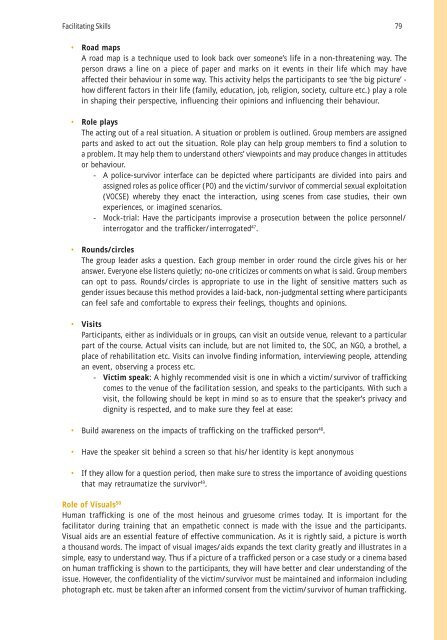Manual for Training Police on Anti Human Trafficking
Manual for Training Police on Anti Human Trafficking
Manual for Training Police on Anti Human Trafficking
You also want an ePaper? Increase the reach of your titles
YUMPU automatically turns print PDFs into web optimized ePapers that Google loves.
Facilitating Skills<br />
Road maps<br />
A road map is a technique used to look back over some<strong>on</strong>e’s life in a n<strong>on</strong>-threatening way. The<br />
pers<strong>on</strong> draws a line <strong>on</strong> a piece of paper and marks <strong>on</strong> it events in their life which may have<br />
affected their behaviour in some way. This activity helps the participants to see ‘the big picture’ -<br />
how different factors in their life (family, educati<strong>on</strong>, job, religi<strong>on</strong>, society, culture etc.) play a role<br />
in shaping their perspective, influencing their opini<strong>on</strong>s and influencing their behaviour.<br />
Role plays<br />
The acting out of a real situati<strong>on</strong>. A situati<strong>on</strong> or problem is outlined. Group members are assigned<br />
parts and asked to act out the situati<strong>on</strong>. Role play can help group members to find a soluti<strong>on</strong> to<br />
a problem. It may help them to understand others’ viewpoints and may produce changes in attitudes<br />
or behaviour.<br />
- A police-survivor interface can be depicted where participants are divided into pairs and<br />
assigned roles as police officer (PO) and the victim/survivor of commercial sexual exploitati<strong>on</strong><br />
(VOCSE) whereby they enact the interacti<strong>on</strong>, using scenes from case studies, their own<br />
experiences, or imagined scenarios.<br />
- Mock-trial: Have the participants improvise a prosecuti<strong>on</strong> between the police pers<strong>on</strong>nel/<br />
interrogator and the trafficker/interrogated 47 .<br />
Rounds/circles<br />
The group leader asks a questi<strong>on</strong>. Each group member in order round the circle gives his or her<br />
answer. Every<strong>on</strong>e else listens quietly; no-<strong>on</strong>e criticizes or comments <strong>on</strong> what is said. Group members<br />
can opt to pass. Rounds/circles is appropriate to use in the light of sensitive matters such as<br />
gender issues because this method provides a laid-back, n<strong>on</strong>-judgmental setting where participants<br />
can feel safe and com<str<strong>on</strong>g>for</str<strong>on</strong>g>table to express their feelings, thoughts and opini<strong>on</strong>s.<br />
Visits<br />
Participants, either as individuals or in groups, can visit an outside venue, relevant to a particular<br />
part of the course. Actual visits can include, but are not limited to, the SOC, an NGO, a brothel, a<br />
place of rehabilitati<strong>on</strong> etc. Visits can involve finding in<str<strong>on</strong>g>for</str<strong>on</strong>g>mati<strong>on</strong>, interviewing people, attending<br />
an event, observing a process etc.<br />
- Victim speak: A highly recommended visit is <strong>on</strong>e in which a victim/survivor of trafficking<br />
comes to the venue of the facilitati<strong>on</strong> sessi<strong>on</strong>, and speaks to the participants. With such a<br />
visit, the following should be kept in mind so as to ensure that the speaker’s privacy and<br />
dignity is respected, and to make sure they feel at ease:<br />
Build awareness <strong>on</strong> the impacts of trafficking <strong>on</strong> the trafficked pers<strong>on</strong> 48 .<br />
Have the speaker sit behind a screen so that his/her identity is kept an<strong>on</strong>ymous<br />
If they allow <str<strong>on</strong>g>for</str<strong>on</strong>g> a questi<strong>on</strong> period, then make sure to stress the importance of avoiding questi<strong>on</strong>s<br />
that may retraumatize the survivor 49 .<br />
Role of Visuals 50<br />
<strong>Human</strong> trafficking is <strong>on</strong>e of the most heinous and gruesome crimes today. It is important <str<strong>on</strong>g>for</str<strong>on</strong>g> the<br />
facilitator during training that an empathetic c<strong>on</strong>nect is made with the issue and the participants.<br />
Visual aids are an essential feature of effective communicati<strong>on</strong>. As it is rightly said, a picture is worth<br />
a thousand words. The impact of visual images/aids expands the text clarity greatly and illustrates in a<br />
simple, easy to understand way. Thus if a picture of a trafficked pers<strong>on</strong> or a case study or a cinema based<br />
<strong>on</strong> human trafficking is shown to the participants, they will have better and clear understanding of the<br />
issue. However, the c<strong>on</strong>fidentiality of the victim/survivor must be maintained and in<str<strong>on</strong>g>for</str<strong>on</strong>g>mai<strong>on</strong> including<br />
photograph etc. must be taken after an in<str<strong>on</strong>g>for</str<strong>on</strong>g>med c<strong>on</strong>sent from the victim/survivor of human trafficking.<br />
79

















